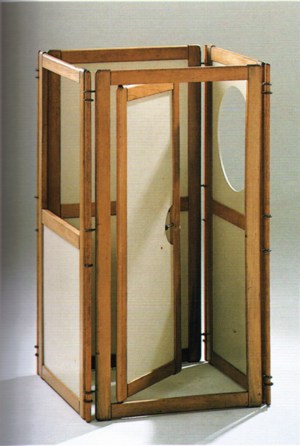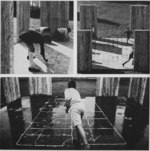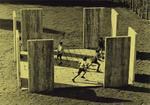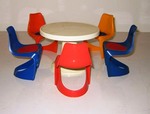Wait, you mean the Stephan Gip? The guy who designed the original trapezoidal high chair that has been knocked off and sold to every sitdown restaurant in the Western Hemisphere, that Stephan Gip? Yep.

Ever since seeing that Enzo Mari cardboard screen the other day, I haven't been able to get the idea of play screens out of my head. [I know, welcome to my life. Did you know it was called "The Place For Games"?]
Kids so rarely get control of their own space; they're usually at grown-ups' mercy, either stuck with what we give them, or requiring help to build a blanket fort. Or they improvise, finding weird, invisible nooks in adult space: under tables, behind doors, in between the sofa and the wall. [Or they go to Ikea. There's an egg-shaped chair there with a little pull-down canopy, and I swear, the kid could sit there all night opening and closing that thing; she was in cocoon heaven.]
With a screen, kids can set up and configure their surroundings for themselves just as they already do with blocks. If the system is simple enough and sized right, they can actually do it all themselves, even at an early age. [I mean like 2-3. I see something like Scott Klinker's cool SpaceFrame and YooDo building sets, and I think a kid'd have to be 4 before she could build one of those herself. Or am I wrong?]
Anyway, I was flipping back through Vitra's Kid-Size catalogue, looking for other screens, and it turns out one of the coolest, simplest ones was this 1970 version by Stephan Gip, designed for Scrivit. Check this out:
Stephan Gip was one of Sweden's leading designers of children's furniture and equipment, whose degree show project at the Konstfack was for a combined bunkbed [! -ed.] and play centre. His commercial ranges for Scrivit from the early 1960s were designed for both home and nursery. This was a cross-disciplinary approach, developed with child psuchologist Stina Sandels of Stockholm University, which attracted much media attention. Gip's folding screen is highly adaptable and has multiple uses--as a cupboard, for puppet shows and other forms of play. [emphasis added]Whoa, who knew? Almost none of that media attention is evident on the English-language web. Between his 1959 "Fun on Wheels" riding/construction set and this screen, there's a missing decade of Gippian kid design that I, for one, want to hear about. I'm going to do some digging and see what is up.
Gip's screen is bigger than Mari's--120cm vs 90cm--and is more furniture than toy. It's got that Scandivanian modernist severity that, like a modular airport hotel room, may not age well. But it's kind of slick, too, and simple enough to inspire a woodworking dad [or mom, sure, it's 2007] to bang something together.
Previously: "Fun on Wheels," 1959, by Stephan Gip





